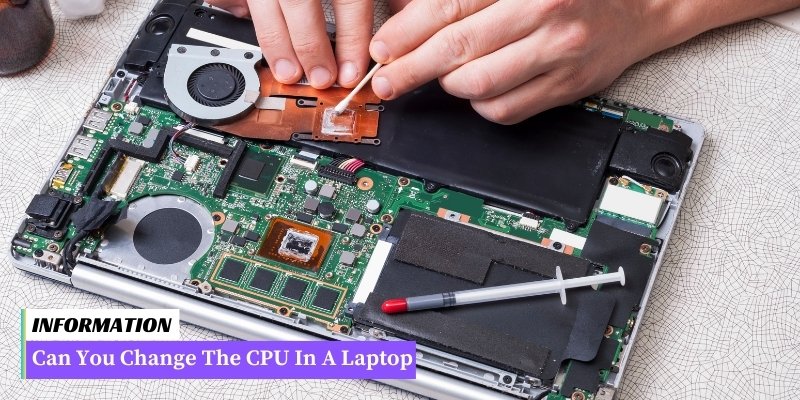Yes, it is possible to change the CPU in a laptop if it has a socketed CPU; however, most modern laptops have CPUs soldered onto the motherboard, which makes replacement challenging.
Changing the CPU in a laptop can be a viable option for enhancing performance, but it’s a process fraught with potential complications.
Unlike desktops, many laptops are designed with space constraints and have their central processing units (CPUs) permanently attached to the motherboard. Despite this, some gaming or professional laptops are built to allow CPU upgrades.
Before considering such an upgrade, it’s crucial to verify compatibility with your laptop’s motherboard and to be mindful of how the change may affect your warranty.
Table of Contents
I. Benefits of Changing the CPU in a Laptop
Upgrading the CPU (Central Processing Unit) in a laptop can bring several benefits, enhancing the overall performance and functionality of the device.
Here are some advantages of changing the CPU:
1. Improved Processing Power
By upgrading the CPU, you can significantly increase the processing power of your laptop. This allows for faster multitasking, smoother performance, and quicker execution of demanding tasks such as video editing, gaming, and running resource-intensive software.
2. Enhanced Speed and Responsiveness
A more powerful CPU can enhance the speed and responsiveness of your laptop. Applications will launch faster, files will be processed more quickly, and overall system responsiveness will be improved, leading to a more efficient and enjoyable user experience.
3. Better Compatibility with Latest Software
As software applications and operating systems evolve, they often require more processing power to run smoothly. By upgrading the CPU, you ensure that your laptop remains compatible with the latest software releases, allowing you to take advantage of new features and improvements.
4. Extended Lifespan of the Laptop
Changing the CPU can breathe new life into an older laptop, extending its usability and lifespan.
Rather than investing in an entirely new device, upgrading the CPU can provide a cost-effective solution to keep your laptop up to date and capable of handling modern computing demands.
5. Potential for Overclocking
If you are an advanced user or a gamer looking to push the limits of your laptop’s performance, upgrading the CPU may allow for overclocking.
Overclocking refers to increasing the clock speed of the CPU beyond its default settings, resulting in even higher performance. However, this should be done cautiously, as it may lead to increased heat generation and potential stability issues.
II. Considerations Before Changing the CPU in a Laptop
Before diving into the process of changing the CPU in a laptop, there are several important considerations to keep in mind.
These factors can greatly impact the success and outcome of the CPU replacement:
- Compatibility: It is crucial to ensure that the new CPU you plan to install is compatible with your laptop’s motherboard. Check the manufacturer’s specifications and documentation to determine the supported CPU models.
- Power and Thermal Requirements: Different CPUs have varying power and thermal requirements. Make sure that your laptop’s cooling system can handle the increased power and heat generated by the new CPU. Upgrading the cooling system may be necessary in some cases.
- Bios and Firmware Updates: Some laptops require a BIOS or firmware update to support a new CPU. Check the manufacturer’s website for any available updates and follow the instructions carefully to avoid any issues.
- Warranty and Support: Changing the CPU in a laptop may void the warranty. Consider whether you are willing to take the risk and if you have the technical expertise to troubleshoot any potential problems that may arise.
- Data Backup: Before attempting any hardware changes, it is essential to back up all your important data. This will protect your files in case something goes wrong during the CPU replacement process.
- Tools and Resources: Gather all the necessary tools and resources before starting the CPU replacement. This may include a screwdriver set, thermal paste, and an anti-static wrist strap to prevent damage from static electricity.
III. Step-by-Step Guide to Changing the CPU in a Laptop
Changing the CPU in a laptop can be a complex process, but with careful planning and attention to detail, it is definitely achievable.
Here is a step-by-step guide to help you through the process:
- Research and compatibility check: Before proceeding, make sure to research and identify a compatible CPU upgrade for your specific laptop model. Check the manufacturer’s website or consult with a computer expert if needed.
- Gather necessary tools: You will need a set of precision screwdrivers, thermal paste, an anti-static wrist strap, and a clean, well-lit workspace. Ensure you have all the required tools before starting.
- Prepare the laptop: Shut down the laptop, unplug it from the power source, and remove the battery. This will prevent any electrical mishaps and ensure your safety during the process.
- Access the CPU: Locate and remove the laptop’s bottom cover or access panel. This will give you access to the CPU socket. Be careful not to damage any other components while doing this.
- Remove the existing CPU: Carefully unlock the CPU socket and gently lift the CPU out of its socket. Take note of any orientation marks on the CPU and socket to ensure correct placement of the new CPU.
- Apply thermal paste: Clean the old thermal paste from the heatsink and CPU using isopropyl alcohol and a lint-free cloth. Apply a small amount of new thermal paste to the center of the CPU. This will help with heat transfer.
- Install the new CPU: Align the new CPU with the socket, ensuring the orientation marks match. Gently place the CPU into the socket and lock it in place. Be cautious not to exert excessive force.
- Reassemble the laptop: Carefully put the laptop’s bottom cover or access panel back in place. Make sure all screws are securely tightened. Reinsert the battery and connect the laptop to the power source.
- Test and monitor: Power on the laptop and check if it boots up properly. Monitor the CPU temperature using appropriate software to ensure it is within safe limits. If everything looks good, congratulations on successfully changing the CPU in your laptop!
Remember, it is always recommended to consult professional help or manufacturer’s guidelines if you are unsure or uncomfortable with performing these steps yourself.
Improper handling can lead to damage and void warranties. Proceed with caution and take your time to ensure a successful CPU upgrade.
Frequently Asked Questions about Changing the CPU in a Laptop
1. Can I upgrade the CPU in my laptop?
Yes, in some cases it is possible to upgrade the CPU in a laptop, but it depends on the specific model and its compatibility with different processors.
2. How do I know if my laptop’s CPU can be changed?
You can check the specifications of your laptop model or consult the manufacturer’s website to determine if the CPU is replaceable or soldered onto the motherboard.
3. What tools do I need to change the CPU in a laptop?
Typically, you will need a small screwdriver set, thermal paste, and an anti-static wristband to safely remove and replace the CPU.
4. Can I upgrade to any CPU model in my laptop?
No, laptops have specific CPU socket types and thermal design power (TDP) limitations, so you need to ensure that the new CPU is compatible with your laptop’s motherboard.
5. Will changing the CPU void my laptop’s warranty?
In most cases, upgrading the CPU yourself will void the warranty. It is recommended to check the warranty terms or consult the manufacturer before attempting any modifications.
6. Is changing the CPU in a laptop difficult?
It can be challenging, especially for inexperienced users. It involves disassembling the laptop, handling delicate components, and applying thermal paste correctly. Professional assistance is recommended if you are unsure.
7. What are the benefits of changing the CPU in a laptop?
Upgrading the CPU can improve overall performance, enhance multitasking capabilities, and allow for smoother running of demanding applications or games.
8. Are there any risks associated with changing the CPU in a laptop?
Yes, there are risks involved, such as damaging the motherboard, voiding the warranty, or encountering compatibility issues. It is crucial to research and follow proper procedures.
9. Can changing the CPU in a laptop solve overheating issues?
In some cases, upgrading to a more efficient CPU with lower power consumption can help reduce overheating. However, it is essential to address other potential causes of overheating as well.
10. Should I consider upgrading the CPU or buying a new laptop?
It depends on your specific needs, budget, and the overall condition of your laptop. If the upgrade is not feasible or cost-effective, purchasing a new laptop might be a better option.
Conclusion: Can You Change The Cpu In A Laptop
Changing the CPU in a laptop is possible, but it is not a straightforward process and may not be feasible for all laptops. It requires technical expertise, compatibility considerations, and may void the warranty.
Additionally, some laptops have soldered CPUs that cannot be replaced. It is recommended to consult with a professional or refer to the laptop manufacturer’s guidelines before attempting to change the CPU in a laptop.






